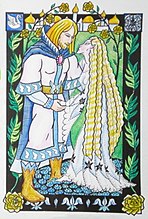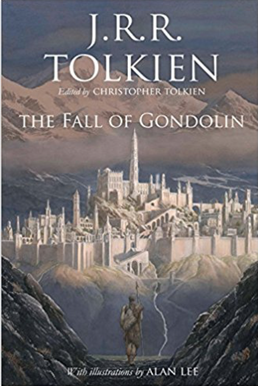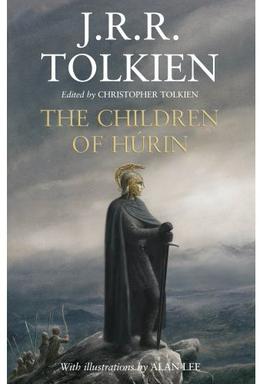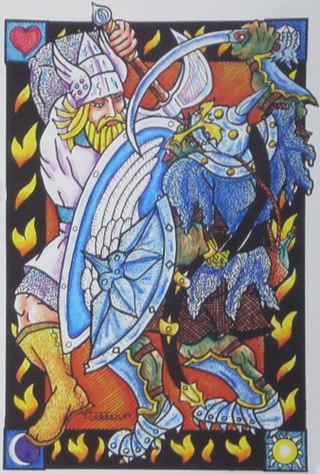Fictional history

Tuor Eladar, also known as Ulmondil ("The Blessed of Ulmo"), is the central character of The Fall of Gondolin . [1] He is a great hero of the Third House of Men in the First Age of Middle-earth, the only son of Huor and Rían and the cousin of the ill-fated Túrin Turambar. Huor is killed covering the retreat of Turgon, King of Gondolin, in the Battle of Tears Unnumbered, the Nírnaeth Arnoediad . Rían, having received no news of her husband, becomes distraught and wanders into the wild. She is taken care of by the local Grey-elves, and before the end of the year she bears a son and calls him Tuor. But she delivers him to the care of the Elves and departs, dying upon the lonely green grave-mound, the Hill of the Slain, at the site of the Battle of Tears Unnumbered. [T 1]
Tuor is fostered by the Elves in the caves of Androth in the Mountains of Mithrim, in the Hithlum region of Beleriand, living a hard and wary life. When Tuor is sixteen their leader Annael decides to leave, but during the march his people are scattered. Tuor is captured by the Easterlings, Men who had been sent there by the Dark Lord Morgoth and who had cruelly oppressed the few people left there. After three years of thraldom under Lorgan the Easterling, Tuor escapes and returns to the caves. [T 1]
For four years he lives as an outlaw, seeing no way of escape from the region of Dor-lómin, which is bordered by mountains. He kills many of the Easterlings that he comes upon during his journeys, and his name is feared. Meanwhile, the godlike Vala Ulmo, Lord of Waters, hears of Tuor's plight and chooses Tuor to bear a message of warning to Turgon, Lord of the Hidden City of Gondolin. By Ulmo's power a spring near Tuor's cave overflows, and following the stream Tuor crosses Dor-lómin to the mountains of Ered Lómin. Under the guidance of two Elves sent there by Ulmo, Gelmir and Arminas, he passes through the ancient Gate of the Noldor into the land of Nevrast, becoming the first Man to reach the shore of the Great Sea, Belegaer. From there he is led by seven swans, arriving at last at Turgon's old dwellings at Vinyamar. [T 1]
Tuor finds arms and armour in the ruins of Vinyamar, and meets Ulmo himself on the seashore. Ulmo appoints Tuor to be his messenger, and tells him to seek King Turgon in Gondolin. He gives Tuor the Elf Voronwë as his guide. Voronwë leads Tuor along the southern slopes of Ered Wethrin, and they catch a brief glimpse of Tuor's cousin Túrin near the Pools of Ivrin, the only time the paths of the two ever cross. Journeying through the harsh winter, they reach the hidden city of Gondolin. Tuor tells Turgon of Ulmo's warning that Morgoth now knows of Gondolin's existence, and is about to destroy it, but Turgon refuses to abandon the city. [T 1]
Tuor remains in the city and falls in love with Turgon's only child, Idril Celebrindal, whose mother Elenwë died crossing the northern ice during the Elves' return from Valinor. In contrast to the first union of Elves and Men, that between Lúthien and Beren, Tuor and Idril are allowed to marry without difficulty. Their wedding is celebrated with great mirth and joy, as King Turgon had grown fond of Tuor. He makes Tuor the leader of the House of the Swan Wing, one of the twelve houses of Gondolin. Turgon also remembers the last words of Huor, which prophesied that a "star" would arise out of his and Turgon's lineage which would redeem the Children of Ilúvatar (Elves and Men) from Morgoth. However, the marriage angers Turgon's influential nephew Maeglin, who had desired Idril for himself. Maeglin defies Turgon's order to stay within the mountains, and is captured by Orcs during a trip to gather resources. Morgoth promises Maeglin both Gondolin and Idril in return for telling him where the hidden city is. Noticing that Maeglin is behaving suspiciously, Idril decides to construct a secret passage out of Gondolin. [T 1]
During the ensuing sack of Gondolin, Tuor defends Idril and their only child Eärendil from Orcs and the traitorous Maeglin, who threatens to murder the child by throwing him from the city wall. After killing Maeglin, they lead a remnant of the people of Gondolin to escape through the secret passage. In the mountain heights they meet a Balrog, which Glorfindel, chief of the House of the Golden Flower, fights and defeats. They reach the estuary of the Mouths of Sirion; Tuor and his people live there for a while, also founding a town on the Isle of Balar. [T 1]
Longing for the Sea, Tuor builds the ship Eärramë ("Sea-wing"). He and Idril sail to the West; the Elves and Men of Beleriand believe that the two of them arrived in Valinor, bypassing the Ban of the Valar that prohibited mortals from entering the Undying Lands, and that Tuor alone of Men is allowed to be treated as an Elf. Eärendil inherits the Elfstone Elessar from Idril; it is a magical green gem which bestows healing powers on those who touch it. The Elfstone is passed down to their descendant Aragorn by the end of the Third Age, as narrated in The Lord of the Rings ; when he becomes king, he takes the name Elessar. [2] [3] [T 1]
- Illustrations by Tom Loback, 2007
- The wedding of Tuor and Idril
- Battle for Gondolin:
Tuor kills the Orc Othrod
Family tree
| Half-elven family tree [T 2] [T 3] | |||||||||||||||||||||||||||||||||||||||||||||||||||||||||||||||||||||||||||||||||||||||||||||||||||||||||||||||||||||||||||||||||||||||||||||||||||||||||||||||||||||||||||||||||||||||||||||||||||||||||||||||||||||||||||||||||||||||||||||||||||||||||||||||||||||||||||||||||||||||||||||||||||||||||||||||||||||||||||||||||||||||||||||||||||||||||||||||||||||||||||||||||||||||||||||||||||||||||||||||||||||||||||||||||||||||||||||||||||||||||||||||||||||||||||||||||||||||||||||||||||||||||||||||||||||||||||||||||||||||||||||||||||||||||||||||||||||||||||||||||||||||||||||||||||||||||||||||||||||||||||||||||||||||||||||||||||||||||||||||||||||||||||||||||||||||||||||||||||||||||||||||||||||||||||||||||||||||||||||||||||||||||||||||||||||||||||||||||||||||||||||||||||||||||||||||||||||||||||||||||||||||||||||||||||||||||||||||||||||||||||||||||||||||||||||||||||||||||||||||||||||||||||||||||||||||||||||||||||||||||||||||||||||||||||||||||||||||||||||||||||||||||||||||||||||||||||||||||||||||
|---|---|---|---|---|---|---|---|---|---|---|---|---|---|---|---|---|---|---|---|---|---|---|---|---|---|---|---|---|---|---|---|---|---|---|---|---|---|---|---|---|---|---|---|---|---|---|---|---|---|---|---|---|---|---|---|---|---|---|---|---|---|---|---|---|---|---|---|---|---|---|---|---|---|---|---|---|---|---|---|---|---|---|---|---|---|---|---|---|---|---|---|---|---|---|---|---|---|---|---|---|---|---|---|---|---|---|---|---|---|---|---|---|---|---|---|---|---|---|---|---|---|---|---|---|---|---|---|---|---|---|---|---|---|---|---|---|---|---|---|---|---|---|---|---|---|---|---|---|---|---|---|---|---|---|---|---|---|---|---|---|---|---|---|---|---|---|---|---|---|---|---|---|---|---|---|---|---|---|---|---|---|---|---|---|---|---|---|---|---|---|---|---|---|---|---|---|---|---|---|---|---|---|---|---|---|---|---|---|---|---|---|---|---|---|---|---|---|---|---|---|---|---|---|---|---|---|---|---|---|---|---|---|---|---|---|---|---|---|---|---|---|---|---|---|---|---|---|---|---|---|---|---|---|---|---|---|---|---|---|---|---|---|---|---|---|---|---|---|---|---|---|---|---|---|---|---|---|---|---|---|---|---|---|---|---|---|---|---|---|---|---|---|---|---|---|---|---|---|---|---|---|---|---|---|---|---|---|---|---|---|---|---|---|---|---|---|---|---|---|---|---|---|---|---|---|---|---|---|---|---|---|---|---|---|---|---|---|---|---|---|---|---|---|---|---|---|---|---|---|---|---|---|---|---|---|---|---|---|---|---|---|---|---|---|---|---|---|---|---|---|---|---|---|---|---|---|---|---|---|---|---|---|---|---|---|---|---|---|---|---|---|---|---|---|---|---|---|---|---|---|---|---|---|---|---|---|---|---|---|---|---|---|---|---|---|---|---|---|---|---|---|---|---|---|---|---|---|---|---|---|---|---|---|---|---|---|---|---|---|---|---|---|---|---|---|---|---|---|---|---|---|---|---|---|---|---|---|---|---|---|---|---|---|---|---|---|---|---|---|---|---|---|---|---|---|---|---|---|---|---|---|---|---|---|---|---|---|---|---|---|---|---|---|---|---|---|---|---|---|---|---|---|---|---|---|---|---|---|---|---|---|---|---|---|---|---|---|---|---|---|---|---|---|---|---|---|---|---|---|---|---|---|---|---|---|---|---|---|---|---|---|---|---|---|---|---|---|---|---|---|---|---|---|---|---|---|---|---|---|---|---|---|---|---|---|---|---|---|---|---|---|---|---|---|---|---|---|---|---|---|---|---|---|---|---|---|---|---|---|---|---|---|---|---|---|---|---|---|---|---|---|---|---|---|---|---|---|---|---|---|---|---|---|---|---|---|---|---|---|---|---|---|---|---|---|---|---|---|---|---|---|---|---|---|---|---|---|---|---|---|---|---|---|---|---|---|---|---|---|---|---|---|---|---|---|---|---|---|---|---|---|---|---|---|---|---|---|---|---|---|---|---|---|---|---|---|---|---|---|---|---|---|---|---|---|---|---|---|---|---|---|---|---|---|---|---|---|---|---|---|---|---|---|---|---|---|---|---|---|---|---|---|---|---|---|---|---|---|---|---|---|---|---|---|---|---|---|---|---|---|---|---|---|---|---|---|---|---|---|---|---|---|---|---|---|---|---|---|---|---|---|---|---|---|---|---|---|---|---|---|---|---|---|---|---|---|---|---|---|---|---|---|---|---|---|---|---|---|---|---|---|---|---|---|---|---|---|---|---|---|---|---|---|---|---|---|---|---|---|---|---|---|---|---|---|---|---|---|---|---|---|---|---|---|---|---|---|---|---|---|---|---|---|---|---|---|---|---|---|---|---|---|---|---|---|---|---|---|---|---|---|---|---|---|---|---|---|---|---|---|---|---|---|---|---|---|---|---|---|---|---|---|---|---|---|---|---|---|---|---|---|---|---|---|---|---|---|---|---|---|---|---|---|---|---|---|---|---|---|---|---|---|---|---|---|---|---|---|---|---|---|---|---|---|---|---|---|---|---|---|---|---|---|---|---|---|---|---|---|---|---|---|---|---|---|---|---|---|---|---|---|---|---|---|---|---|---|---|---|---|---|---|---|---|---|---|---|---|---|---|---|---|---|---|---|---|---|---|---|---|---|---|---|---|---|---|---|---|---|---|---|---|---|---|---|---|---|---|---|---|---|---|---|---|---|---|---|---|---|---|---|---|---|---|---|---|---|---|---|
| |||||||||||||||||||||||||||||||||||||||||||||||||||||||||||||||||||||||||||||||||||||||||||||||||||||||||||||||||||||||||||||||||||||||||||||||||||||||||||||||||||||||||||||||||||||||||||||||||||||||||||||||||||||||||||||||||||||||||||||||||||||||||||||||||||||||||||||||||||||||||||||||||||||||||||||||||||||||||||||||||||||||||||||||||||||||||||||||||||||||||||||||||||||||||||||||||||||||||||||||||||||||||||||||||||||||||||||||||||||||||||||||||||||||||||||||||||||||||||||||||||||||||||||||||||||||||||||||||||||||||||||||||||||||||||||||||||||||||||||||||||||||||||||||||||||||||||||||||||||||||||||||||||||||||||||||||||||||||||||||||||||||||||||||||||||||||||||||||||||||||||||||||||||||||||||||||||||||||||||||||||||||||||||||||||||||||||||||||||||||||||||||||||||||||||||||||||||||||||||||||||||||||||||||||||||||||||||||||||||||||||||||||||||||||||||||||||||||||||||||||||||||||||||||||||||||||||||||||||||||||||||||||||||||||||||||||||||||||||||||||||||||||||||||||||||||||||||||||||||||








